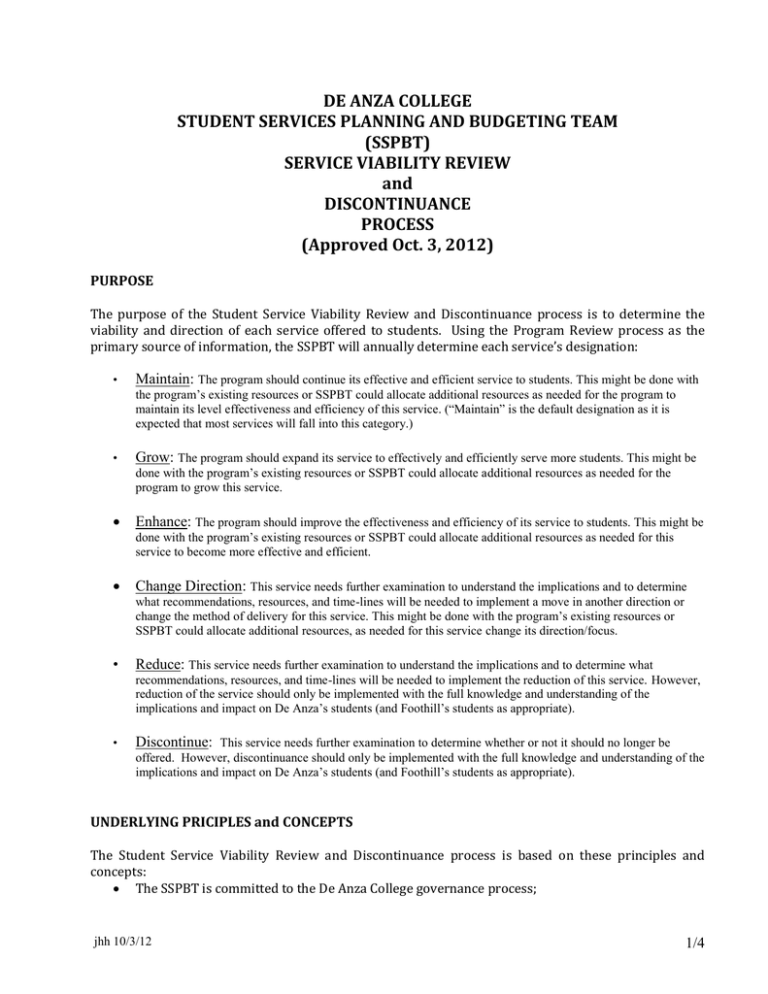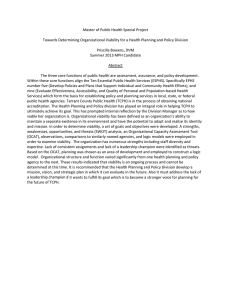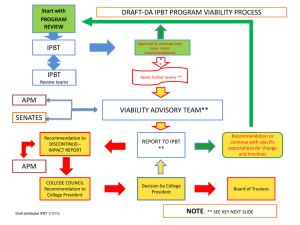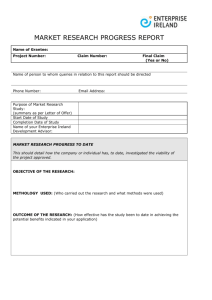SSPBT Viability Narrative 10_3_12.doc
advertisement

DE ANZA COLLEGE STUDENT SERVICES PLANNING AND BUDGETING TEAM (SSPBT) SERVICE VIABILITY REVIEW and DISCONTINUANCE PROCESS (Approved Oct. 3, 2012) PURPOSE The purpose of the Student Service Viability Review and Discontinuance process is to determine the viability and direction of each service offered to students. Using the Program Review process as the primary source of information, the SSPBT will annually determine each service’s designation: • Maintain: The program should continue its effective and efficient service to students. This might be done with the program’s existing resources or SSPBT could allocate additional resources as needed for the program to maintain its level effectiveness and efficiency of this service. (“Maintain” is the default designation as it is expected that most services will fall into this category.) • Grow: The program should expand its service to effectively and efficiently serve more students. This might be done with the program’s existing resources or SSPBT could allocate additional resources as needed for the program to grow this service. Enhance: The program should improve the effectiveness and efficiency of its service to students. This might be done with the program’s existing resources or SSPBT could allocate additional resources as needed for this service to become more effective and efficient. Change Direction: This service needs further examination to understand the implications and to determine what recommendations, resources, and time-lines will be needed to implement a move in another direction or change the method of delivery for this service. This might be done with the program’s existing resources or SSPBT could allocate additional resources, as needed for this service change its direction/focus. • Reduce: This service needs further examination to understand the implications and to determine what recommendations, resources, and time-lines will be needed to implement the reduction of this service. However, reduction of the service should only be implemented with the full knowledge and understanding of the implications and impact on De Anza’s students (and Foothill’s students as appropriate). • Discontinue: This service needs further examination to determine whether or not it should no longer be offered. However, discontinuance should only be implemented with the full knowledge and understanding of the implications and impact on De Anza’s students (and Foothill’s students as appropriate). UNDERLYING PRICIPLES and CONCEPTS The Student Service Viability Review and Discontinuance process is based on these principles and concepts: The SSPBT is committed to the De Anza College governance process; jhh 10/3/12 1/4 Through the Student Services Program Review process, the college systematically determines the viability and direction of its services to students; The systematic review of programs and services is ongoing, including in times of “extreme financial hardship” for the college and district; The procedures and assessment criteria used to determine the viability and direction of a service are clearly articulated and transparent; The Student Services Program Review process and the service reduction or discontinuance process are distinctly different. Any proposal, to reduce or discontinue a service must be considered in the context of impact for both colleges in the district; Insofar as a proposal to reduce or discontinue a service impacts employment, the collective bargaining units involved will be given the necessary time to resolve collective bargaining issues in accordance with their respective agreements. Student Services Planning and Budget Team (SSPBT) SERVICE VIABILITY and DISCONTINUANCE PROCESS OVERVIEW (See flow chart) 1. The Service Viability Review and Discontinuance process begins with submission to the SSPBT of a Comprehensive Program Review (CPR) or Annual Program Review Updates (APRU) from each Student Services program. a. Each program review submitted includes a program recommendation for each service it offers as to whether the service should be maintained, allowed to grow, be enhanced, change direction, be reduced, or be discontinued. 2. Each year, members of the SSPBT form into teams that read and assess two or three program reviews (CPR or APRU). 3. The reader teams report their findings and recommendations to the SSPBT. 4. The SSPBT then determines whether a service is viable or needs further investigation. a. If declared viable (It is anticipated that most services will be declared viable.) i. The service is given a maintain, grow, or enhance designation, ii. The service re-enters the Program Review process, and iii. The IPBT and FERPBT are informed of the SSPBTs viability designations. b. If not declared viable, there are questions about the viability of the service as it is currently offered and further investigation is needed. 5. If the SSPBT determines that there questions that indicate a service needs further investigation, a Viability Advisory Group (a SSPBT task group) will convene. a. The charge of the Viability Advisory Group is to: i. Recommend to the SSPBT the viability and direction of the service. Options would include changing the direction of the service, reducing the service, or discontinuing the service. ii. Develop a Preliminary Impact Report based on the recommendation jhh 10/3/12 2/4 b. The Viability Advisory Group will be co-chaired by one of the SSPBT co-chairs. c. The membership will consist of (at a minimum): i. ii. iii. iv. v. vi. vii. The administrator over the program that provides the service in question, The program/department head (if not the administrator), A program faculty member, A program classified staff member, An Academic Senate representative from Instruction, A Classified Senate Officer, and Others as appropriate (students, Union representative, an IPBT representative, etc.) 6. Process: The Viability Advisory Group will further investigate and assess the effectiveness, efficiency, and viability of the service in question. a. The Viability Advisory Group will discuss the available quantitative and qualitative data. b. The Viability Advisory Group will review the program structure and goals, and identify measures that could be taken to make the program more effective, efficient, and viable. c. The other PBTs will be informed that a Viability Advisory Group process is in progress and will be informally invited to provide information and input. d. Foothill College Student Services will be informed that a Viability Advisory Group process is in progress and will be informally invited to provide information of the possible impact upon their students. These discussions may include the possibility of transferring the service or consolidating the service with Foothill College. e. The summary of the Viability Advisory Group’s findings and recommendations in the form of a Preliminary Impact Report will be presented to the SSPBT for discussion. f. After receiving the Viability Advisory Group’s recommendations, the SSPBT may determine that the service is viable but needs to change direction or be reduced. In both cases, SSPBT establishes recommendations, guidelines, and implementation timelines for the service to become more viable. The service then reenters the program review process. g. After receiving the Viability Advisory Group’s recommendations, the SSPBT may determine that the service’s viability is seriously in question and could possibly be discontinued, but not without further investigation. 5. Process: Service Discontinuance: a. The SSPBT will develop a Discontinuance Impact Report including: Impact on De Anza College students; Impact on Foothill College students; Impact on the local community; Other unique impacts related to the service, as appropriate. A timeline for a phasing-out period to ensure that all students, administration, faculty and staff are well informed that the service will be discontinued. b. The SSPBT will consult with the other PBTs regarding the impact of discontinuance. c. The SSPBT will consult with the Foothill College regarding the impact of discontinuance. d. The SSPBT will deliberate on the findings in the Discontinuance Impact Report before making its recommendation. The SSPBT has the option to: 1. Not discontinue the service but to determine that the service should change direction or be reduced, or jhh 10/3/12 3/4 2. Recommend to the College Council to discontinue the service 6. In the event that the district administration declares a time of “extreme financial hardship,” and time doesn’t reasonably allow for all of the above to occur, all parties will make reasonable effort to ensure a transparent and participatory process takes place. Qualitative* and quantitative** data must be used in discussions of service viability and discontinuance. Any and all potential issues and problems associated with a service’s viability or discontinuance should come to light during the Program Review process. There must be multiple opportunities built into the Program Review process for faculty, administrators, and classified staff to communicate clearly and explicitly about the vitality of the services. Though not required, part-time faculty are invited to participate in the Program Review and Service Viability Review and Discontinuance process and procedure. *Qualitative data may include the following: Existence of a transfer major for programs primarily intended to support the college’s transfer mission; Program articulation with transfer institutions; Alignment with or duplication within overall college curriculum; Alignment with the college mission and/or strategic initiatives; Outcomes assessment subjective results and reflections; Student, faculty, staff expertise and input; Other qualitative data detected and explicitly identified as potentially problematic during the program review process. **Quantitative data – The impact of the service on: Retention, persistence, and completion rates; Enrollment trends; Frequency of course offerings; Workplace demand for programs primarily intended to support the college’s career/workforce mission; Student Equity; Program-Level, Student Learning, and/or Student Services Learning Outcome assessment data. jhh 10/3/12 4/4



